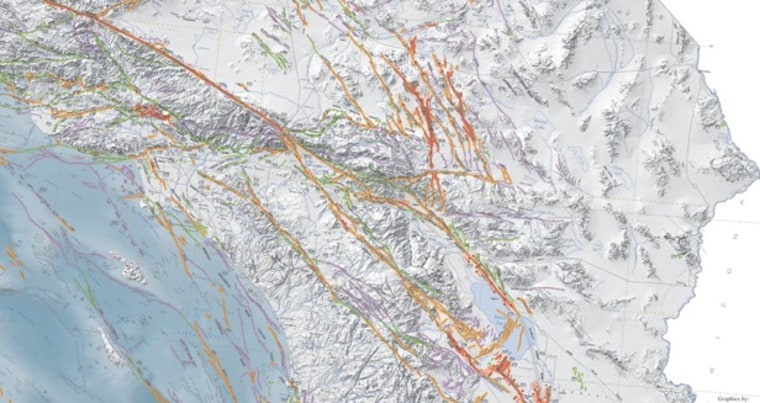California geology officials have released an updated state seismic activity map that they hope will improve earthquake preparedness and construction decisions.
The map, which had not been updated since 1994, includes more than 50 surface fault lines discovered over the last two decades and compiled in a painstaking process.
The map was unveiled Tuesday at The Tech Museum in San Jose as the California Geological Survey celebrated its 150th anniversary. The Geological Survey also presented an updated version of a second map that identifies the makeup of rock and soil.
State geologist John Parrish said the maps can help guide decisions about where to build schools and hospitals and where construction standards need to be higher.
"These maps are used to make a lot of other maps, to map landslides ... for tsunami coastal mapping," Parrish said. "They can tell you what kind of a surface you're building on, and how close you are to a fault."
The new maps are far more detailed than the previous editions and have interactive digital versions that are linked to Google Maps. Distortions from a prior digitizing process that placed some features more than a half-mile from their actual locations were corrected.
Hanging on walls statewide
Chris Wills, supervising engineering geologist in charge of the project, said Wednesday that he envisions the map hanging on the walls at university geology departments and consulting firms that do earthquake hazards work and perhaps being issued by planning departments.
"It really puts the earthquake hazard in context: Where do our earthquakes come from? Where are the most active faults distributed in the state? Where are the most recently active faults that we would tend to worry about most in the state of California? Where are they less common?" he said.
For individual communities or property owners, detailed maps of smaller areas are available, he said.
The more than 50 additional surface fault lines, among an estimated 15,000 faults in the state, are new to the statewide seismic activity map but have been mapped previously.
Some of these faults announced themselves long ago, including the system which unleashed the magnitude-7.1 Hector mine quake in 1999. That quake rocked Southern California and neighboring states but didn't cause much damage because of the remoteness of its epicenter in the Mojave Desert.
"The public knew about the faults that triggered the Hector mine earthquake as soon it stopped shaking. They knew that something big happened out there," said Wills.
Those faults were mapped within a few weeks but hadn't been incorporated into California's statewide map until now, he said.
Not all faults are on the map
The map, however, does not display faults like those that caused the 1994 Northridge quake that caused billions of dollars of destruction and dozens of deaths in metropolitan Los Angeles, or the 1983 quake that wrecked most of downtown Coalinga and damaged hundreds of homes in the Central Valley city.
Such faults aren't on the map because they are "blind thrusts" with no surface rupture to depict.
The statewide map is in addition to localized seismic mapping projects required by state law.
Since shortly after the 1971 San Fernando earthquake hit Los Angeles, the state geologist has been required to map surface ruptures to aid planners in preventing construction of buildings on active faults if they are to be used by people. A 1994 law requires mapping of other seismic hazards such as liquefaction or landslides.
Since 1998, the Natural Hazards Disclosure Act has required real estate sellers or their agents to inform potential buyers if a property is within one of these areas.
Wills noted that the just-released fault map is already out of date because the 7.2 quake that struck Baja California on April 4 produced surface ruptures north of the U.S.-Mexico border in Imperial County.
"Anytime you try to do a compilation of everything you know about a state you lag behind studies of an individual area," he said.
